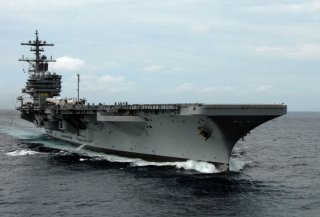U.S. Navy Aircraft Carriers Have an Expensive Problem: Their Toilets
U.S. Navy's USS George HW Bush (CVN 77), the newest Nimitz-class aircraft carrier, as well as the first-in-class USS Gerald R. Ford (CVN-78) are clogging frequently – and unclogging the systems can cost upwards of $400,000.
Here's What You Need to Remember: Unfortunately, this isn't the first time the toilet tissue on the ship has been in the media. In 2011 there were reports that at least twice in the carriers' first year in service all 423 toilets were out of service simultaneously.
The complaints regarding waste in the U.S. military took an interesting turn several months back when it was reported that the toilets on the U.S. Navy's USS George HW Bush (CVN 77), the newest Nimitz-class aircraft carrier, as well as the first-in-class USS Gerald R. Ford (CVN-78) are clogging frequently – and unclogging the systems can cost upwards of $400,000.
In the March report, Navy Shipbuilding: Increasing Focus on Sustainment Early in the Acquisition Process Could Save Billions, released by the Government Accountability Office (GAO), 150 systemic maintenance problems were specifically called out. This included the toilets.
The report noted:
"The Navy used a brand new toilet and sewage system on the CVN 77 and 78, similar to what is on a commercial aircraft, but increased in scale for a crew of over 4,000 people. To address unexpected and frequent clogging of the system, the Navy has determined that it needs to acid flush the CVN 77 and 78's sewage system on a regular basis, which is an unplanned maintenance action for the entire service life of the ship."
According to fleet maintenance officials, each time the acid flush costs around $400,000. However, the Navy still has to determine how often this acid flush is required and on how many ships. Thus the full cost impact still can't be fully quantified.
Unfortunately, this isn't the first time the toilet tissue on the ship has been in the media. In 2011 there were reports that at least twice in the carriers' first year in service all 423 toilets were out of service simultaneously.
Sailors blamed the ship's vacuum system while the Navy blamed sailors for flushing hygiene products. At the time of those issues, sailors also complained of having to walk for an hour to find a working bathroom. The Navy spent 10,000 man-hours fixing the problem, and that apparently included the acid flush.
At the present time, the Navy has no plans to replace the toilet or sewage systems on the carriers – and the same system will reportedly be used on the still in construction USS John F. Kennedy (CVN-79), but it is unclear if the waste system will be deployed on the third and fourth Ford-class carriers – the future USS Enterprise and USS Doris Miller.
This is also just the latest toilet-related issue with the USS Gerald R. Ford. It was the first aircraft carrier to feature gender-neutral bathrooms and has no urinals. The Navy's decision was to increase flexibility when it comes to shifting berthing arrangements for the crew, but critics have noted a number of issues – from the fact that fewer than 18% of all the sailors in the Navy are women, and each toilet takes up more room than wall-mounted urinals.
The biggest issue, Chuck Kaufman, president of the Public Restroom Company, told the Navy Times is that toilets can be less sanitary. "A urinal is a target," said Kaufman. "What is a problem is [with a water closet] you have a very big target and we can't aim very quickly."
Peter Suciu is a Michigan-based writer who has contributed to more than four dozen magazines, newspapers and websites. He is the author of several books on military headgear including A Gallery of Military Headdress, which is available on Amazon.com. This article first appeared earlier this year and is being republished due to reader interest.
Image: Wikimedia

